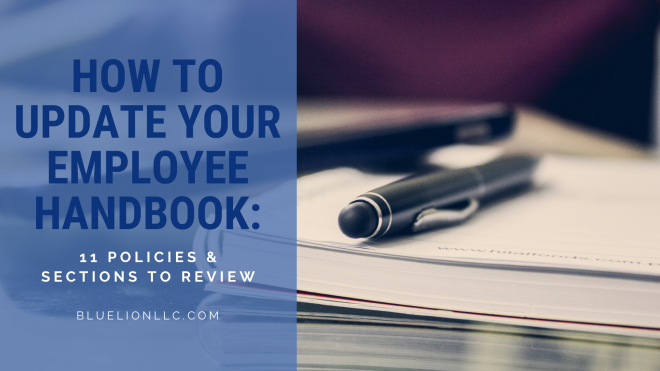
While employers are not legally required to have an employee handbook, this document does the job of clearly informing employees of their rights and can protect your business during lawsuits. Maybe your company already has a handbook—but the work doesn’t end there! You’ll need to review and update it at least annually to ensure your policies are modern and compliant with current laws and regulations.
Why is it so critical to review your handbook regularly? For one thing, outdated, non-compliant policies could leave your company at risk of costly litigation. Check yearly for state, local, and federal compliance and ensure any changes are reflected in your policies. You can find many of these changes on your state’s Department of Labor (DOL) site or consult with your attorney.
You should also ensure your policies align with today’s trends and technology (i.e., social media, cybersecurity, etc.). Not to mention, there is even more to consider since the COVID-19 outbreak, including remote work and paid leave policies.
Keep reading for 11 crucial policies and sections to pay attention to during your yearly employee handbook update process.
11 Employee Handbook Policies & Sections to Review
1. Mission Statement & Core Values
Have you incorporated your organization’s mission statement and core values into your employee handbook? If not, it’s a useful place to do so.
The mission statement defines a company’s why and what, while the values outline how you aim to achieve that mission. In other words, your values provide behavioral guidelines of how all team members are expected to conduct themselves and what kind of culture you aim to create. What better place to remind employees of these expectations than the handbook itself?
2. Multiple Locations
Do you have employees in many different locations? You may need location-specific versions or sections to ensure you address and communicate laws, regulations, and employees’ rights.
Many states, and even some cities, have specific laws and regulations on things like the Family and Medical Leave Act (FMLA), minimum wage regulations, overtime, fair scheduling, paid time off (PTO), meals and breaks, and more. Make sure your handbook and policies comply with the laws in each location where you have employees.
3. Remote Work Policy
Following the COVID-19 pandemic, remote work became the norm for many in 2020. At this point, many businesses have changed up the way they work by converting to fully remote work or hybrid schedules. Whatever your company has decided, your remote work policy should reflect the new practice so that all current and new employees clearly understand expectations.
Is your team returning to the office full-time? Perhaps you already have? You still need to update your policies on providing reasonable accommodations under the Americans with Disabilities Act (ADA) and other anti-discrimination laws. The Equal Employment Opportunity Commission (EEOC) states that allowing an employee to work from home could be a reasonable accommodation if it does not cause undue hardship for the company.
4. Paid Leave Policies
While updating your employee handbook, ensure you are compliant with state and federal laws on paid leave. This goes for PTO and sick leave, too. Check annually for:
- State law sick leave requirements
- State laws on time off for school/child activities
- Parental leave: For both maternal and paternal leave
- Time off to vote: A growing number of employers provide this to encourage people to vote.
- PTO policies (e.g., “use it or lose it” policies are not legal in all states like CA)
- FMLA: Company policy and employee rights must be provided to employees in written form with detailed instructions on how to take leave.
- COVID-related leave: First, the Families First Coronavirus Response Act (FFCRA) required mandatory paid sick or family medical leave. While this is no longer mandatory, this year’s American Rescue Plan Act (ARPA) provides new qualifying reasons and tax credits for emergency paid leave related to COVID.
5. Health & Safety Requirements
Standard Occupational Safety and Health Administration (OSHA) requirements state that the work environment must be “free from recognized hazards that are causing or are likely to cause death or serious physical harm.”
Now, employers must also stay up-to-date with OSHA guidelines and local laws on keeping workers healthy and safe during the pandemic. Some states have enacted COVID-19 worker safety protections for limiting employees’ exposure, while some cities have passed pandemic-related workplace safety ordinances. These laws and regulations are constantly changing throughout the pandemic, so check regularly with your local government.
6. Anti-Discrimination Policies
According to Title VII of the Civil Rights Act of 1964, businesses with at least 15 employees cannot discriminate against workers based on color, national origin, race, religion, and sex. In 2020, the U.S. Supreme Court held that “sex” discrimination under Title VII includes sexual orientation and gender identity.
Make sure your anti-discrimination policy addresses this where appropriate if it does not already. State and local governments are now keeping an eye out for discrimination regarding hairstyles, LGBTQ+, pay, and criminal history matters.
7. Drug Policy
A growing number of states have approved medical and recreational marijuana use, complicating drug policies for employers. Beware of employment discrimination laws regarding medical marijuana patients, and review your drug-testing policy to ensure compliance with your state’s laws.
To ensure employees aren’t using marijuana recreationally during work time, address the issue similarly to alcohol by explaining that while use might be legal, it’s prohibited in the workplace because it impairs employees’ ability to do their jobs.
8. Pay Equity Policies
The federal government will soon begin collecting wage data by position, gender, and other demographics. Be sure your team members are paid fairly and according to local wage laws.
Now is also a good time to update minimum wage posters throughout your workplace and related policies. Ensure your employees are classified and paid properly for exempt vs. non-exempt and hourly vs. salary.
9. Social Media Policy
Make sure your social media policy reflects the most current platforms, which change quickly and constantly. If your social media policy still mentions MySpace or AIM, it is definitely time for an update.
Use this policy to communicate expectations of what is and isn’t acceptable employee use of social media concerning the company. This allows for disciplinary action if an employee misuses social media in a professional way.
Keep in mind that you can’t control how they use social media outside of work, nor can you discipline employees for protected concerted activity on social media.
Your social media and privacy policies should be tied together so that employees know they have little e-privacy when using company-owned devices.
10. Dress Code Policy
Between the growing remote workforce and changing attitudes, the professional dress code has become more relaxed.
While it’s essential to update this policy to remain modern, it also helps your organization be as inclusive as possible about appearance. After all, controlling too strictly what employees can (or cannot) wear, particularly men vs. women, could alienate certain employees and lead to a discrimination lawsuit. To avoid these issues, stick to legitimate, non-discriminatory business reasons for your dress code policy.
11. Cybersecurity Policies
Set rules about employees who want to connect their own devices (e.g., laptops, phones, watches) to company devices and networks. While this may be fine and allowed, you need to ensure you protect the company first. And a well-meaning employee could accidentally unleash a virus that wreaks havoc on your company’s network.
Biometrics, screening, and other forms of identification are becoming more widely used. Consider what type of sensitive information and systems your business has and which security measures will protect vital and confidential data.
Employee Handbook Review
If you can’t remember the last time you and your team updated the employee handbook, it’s high time for a review. A thorough handbook sets expectations for employees and also protects your organization from potentially expensive and reputation-damaging litigation.
Would you rather have an outside view from experienced HR professionals? Contact us to learn more about our handbook development and review services today at 603-818-4131 or info@bluelionllc.com!
The information on this website, including its newsletters, is not, nor is it intended to be, legal advice. You should contact an attorney or HR specialist for advice on your individual situation.


